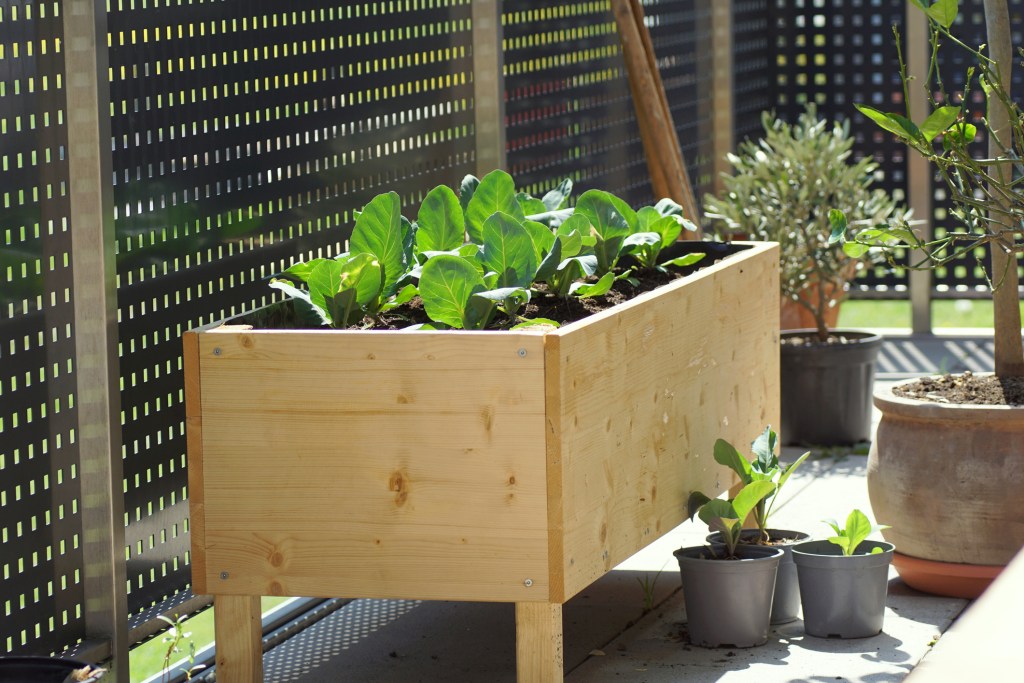Raised garden beds offer a host of benefits. They’re easier on your knees and back, for sure, but they can also be helpful for your plants. Raised garden beds can offer some protection from pests, give you more control over drainage, and conserve space.
There are plenty of garden kits or premade beds that are easy and quick to set up, but you can also make your own. If you’re feeling crafty, or just want a better understanding of how raised garden beds with legs work, then you’re in luck! Here is everything you need to know about how to build a raised garden bed with legs.
What supplies do you need?
Here’s a list of supplies you’ll need for your DIY raised garden bed with legs.
- Weather-resistant wood (cedar or treated pine)
- 8 pieces for the box
- 8 pieces for the legs
- 4 to 6 pieces for the bottom
- Drill or hammer
- Saw
- Screws or nails
- Wood glue
- Landscape cloth
- Hand and eye protection
- Decorations
The size of the wood pieces depends on how large you want your garden to be. To make your box a square, all eight pieces should be the same size. To form a rectangle, four of them should be long, while the other four pieces should be short. All eight pieces should be the same width and height, only the length should differ.
The bottom pieces will sit inside the completed box, so it’s safer to wait until you construct the box to measure and cut these. They will form slats on the bottom, so they should be slightly shorter than the inside of the box. How many you need will be determined by how long your box is. Make sure there is 1 or 2 inches between them, so that water can drain out of the box.

Constructing the garden bed
Lay out four of your box side pieces, two of each length, and then arrange them in a box shape. The shorter ends can go inside or outside the long ones, but make sure you do it the same way on both ends. Ensure the pieces line up evenly and then attach them with screws or nails. Two per corner should be enough, but test the stability of the connection to be sure. You can add the bottom slats now, but they may get in your way later. Repeat this step with the other four box side pieces, so you have two rectangles, but don’t attach them to each other yet.

Making and attaching the legs
Although you can use four narrow pieces (one in each corner for the legs) it is less stable. Instead, use eight flat pieces, two for each corner. These flat pieces should form a right angle on the outside of the box. For extra stability, use wood glue to attach the two flat pieces together to form a single piece in the shape of a right angle.
Then screw or nail the leg to the outside of the first box, so the top of the right angle and the top of the box are level. You can stand the legs up and screw them from the outside, or lay the box down and screw them from the inside. Four to six screws (two to three on each side) are usually enough.
Attach two legs to the first box and then add the second box directly below the first. Make sure you press the two boxes flush against each other, leaving no gaps. This is easier to do with the garden bed lying down, but you can do it standing up with some assistance.
Attach the second box to the legs just like the first box. Then rotate the frame and repeat the process for the remaining two legs. When you’re done, it should resemble a table without a top, and it should be able to stand on its own.

Installing the bottom
To make the bottom of a raised garden bed with legs, cut four to six thin boards so they are just slightly smaller than the box. The slats should run parallel to the short ends of the box and perpendicular to the long sides. Measure the slats carefully, so they are small enough to slide into the bottom of the box but long enough to touch both sides. It may take a few tries to get right. The boards should be flat, although it isn’t the end of the world if they are slightly uneven.
Secure the ends of the boards to the sides of the box, but remember, the slats should not fit tightly against each other. Once they are all secured, lay a piece of landscaping fabric or weed barrier over it. The cloth should be slightly larger than the bottom, so you can secure the edges to the sides of the box with no major gaps. Try to lay the cloth as flat as possible, so any gaps are clearly visible. You can secure the cloth to the sides and the slats with staples, nails, or screws.
That’s all there is to it. Now you can fill your raised garden bed with soil, plant your plants, and watch them grow! Fill the garden bed slowly, and watch for any leaks or cracks. A little bit of spilled soil is fine, but a steady stream may point to a tear in the fabric. Check for cracks in the wood, which will need immediate repair. Then, just enjoy your garden!
Editors' Recommendations
- Everything you need to know about choosing the best rocks for landscaping
- Focus on color: Bring some sunshine to your garden with these orange plants
- Do you live in climate zone 2? Here’s what you need to know
- Could electrogardening be the way of the future?
- Climate zone 3 plants that will thrive in cool temperatures




